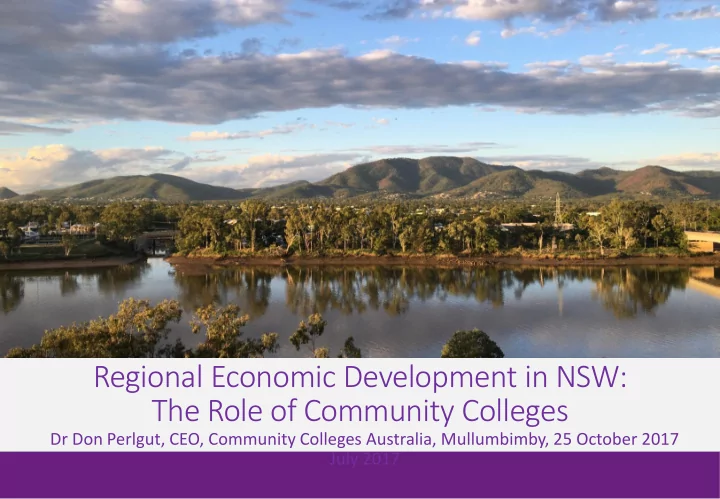

Regional Economic Development in NSW: The Role of Community Colleges Dr Don Perlgut, CEO, Community Colleges Australia, Mullumbimby, 25 October 2017 July 2017
The Tyranny of Distance Rural, regional and remote Australia faces major economic and social challenges based on the “tyranny of distance”: lack of access to services, including education, and resultant poorer economic outcomes. The more “rural” and “remote” you get, the greater the economic and educational challenges you face. Geoffrey Blainey, The Tyranny of Distance , Pan McMillan, 1967, http://www.theaustralian.com.au/arts/review/the-tyranny-of-distance-geoffrey-blaineys-classic-turns-50- /news-story/30477685f87b58523e883f556b40e059 www.cca.edu.au
Rural Education and Young People • Vocational education and training (VET) is an important pathway for regional and remote students. Nearly one-third of remote and outer regional students undertake an apprenticeship or traineeship, far greater than in metropolitan areas. • Rural and remote students have reduced access to education services compared to metropolitan students: attend school less frequently, less likely to go to university and more likely to drop out if they enrol. • Indigenous Australians participate in VET at twice the rate that non- Indigenous Australians do . Remote communities are home to one-quarter of Australia’s Indigenous population. As a consequence, the educational challenges faced in remote areas have a disproportionate impact on Indigenous Australians . http://www.mitchellinstitute.org.au/fact-sheets/young-people-in-rural-and-remote-communities- frequently-missing-out/ www.cca.edu.au
www.cca.edu.au
NSW Regional Community Education Provider Locations Map adapted from https://www.training.nsw.gov.au/about_us/sts_contacts.html www.cca.edu.au
NSW Government-Funded VET Students Student percentages by ARIA accessibility category 2016 Location TAFE % Private % Community % Major cities 63.0 65.3 27.0 Inner regional 25.7 23.9 46.7 Outer regional 9.2 7.6 24.2 Remote 1.5 1.0 1.5 TAFE % Private % Community % Percentage Indigenous Students 2016 8.4 6.3 12.0 Student percentage age breakdown 2016 Age TAFE % Private % Community % 14 to 24 40.1 57.2 30.6 25 to 44 39.0 27.4 34.2 45 and over 20.9 15.3 34.8 Data source: https://www.ncver.edu.au/publications/publications/all-publications/government-funded-students-and-courses-2016 www.cca.edu.au
VET and School Participation by Location Indicator Metro % Inner Outer Remote % Very regional % regional % remote % Participation 7.4 10.7 11.2 11.9 10.4 in VET Secondary 81.2 77.0 73.9 65.6 52.3 School participation age 16 http://www.mitchellinstitute.org.au/fact-sheets/young-people-in-rural-and-remote-communities- Higher ed 36.7 20.1 16.1 13.1 4.3 frequently-missing-out/ participation of school leavers Left school 30.8 41.5 42.3 41.2 50.3 year 10 or below http://phidu.torrens.edu.au/current/graphs/sha-aust/remoteness/aust/education.html Source: Compiled by PHIDU based on data from the NCVER and the ABS Estimated Resident Population, 30 June 2012. www.cca.edu.au
VET Participation by State/Territory Indicator Metro % Inner Outer Remote % Very regional % regional % remote % NSW 6.3 11.9 14.6 15.4 18.5 VIC 10.3 13.9 16.6 19.8 - QLD 5.9 7.8 7.9 8.4 10.4 SA 8.2 10.8 12.5 13.5 12.9 WA 6.1 7.5 10.8 12.1 9.6 http://www.mitchellinstitute.org.au/fact-sheets/young-people-in-rural-and-remote-communities- frequently-missing-out/ TAS - 8.6 10.6 13.4 14.6 NT - - 8.6 13.2 9.9 Australia 7.4 10.7 11.2 11.9 10.4 2012 (released October 2014) Source: http://phidu.torrens.edu.au/current/graphs/sha-aust/remoteness/aust/education.html www.cca.edu.au
Regional and Rural VET Challenges 1. “Thin markets” and unproductive competition. 2. Impact of “contestable” funding models in regional areas with very few providers. 3. Resourcing and costs: lack of managerial attention from centralised state governments, arbitrary funding models that do not account for regional and rural needs. 4. Quality and availability of trainers and assessors. 5. Lack of placement opportunities (including quality providers in certain sectors) for students whose studies require work placements. 6. Poor telecommunications and unreliable internet connections – both providers and students. 7. Online study often not suitable for VET, with requirements for “hands on” activities, and for potentially disengaged learners. 8. Access by students to learning locations: poor public transport. 9. Competition from universities, with secondary schools and other institutions favouring university over VET for school leavers. 10. Issues in border locations (NSW-VIC, SA-VIC, NSW-QLD) of employer registration and approvals. 11. Culture of second and third generation unemployment in certain disadvantaged communities. 12. Aboriginal and Torres Strait Islander communities have special cultural needs not always catered for. www.cca.edu.au
Principles for Innovative Rural and Regional VET Programs: Sample Approaches ➢ Building on local and regional strengths and points of difference ➢ Developing and sustaining partnerships between government, not-for-profit community and businesses ➢ Co-location, such as TAFE-community-high school-university, including sharing facilities and classrooms: TAFE SA & community sector good example of efficient VET partnering ➢ Because funding for training is usually based on “demonstrable” local needs, find ways to create that need ➢ Seek funding from non-local sources ➢ Focus on entrepreneurship, creating a culture of entrepreneurship and risk- taking ➢ Overcome the distances involved in regional, rural and remote Australia www.cca.edu.au
Contact: Dr Don Perlgut, CEO Community Colleges Australia don.perlgut@cca.edu.au tel (02) 9233 3634
Recommend
More recommend